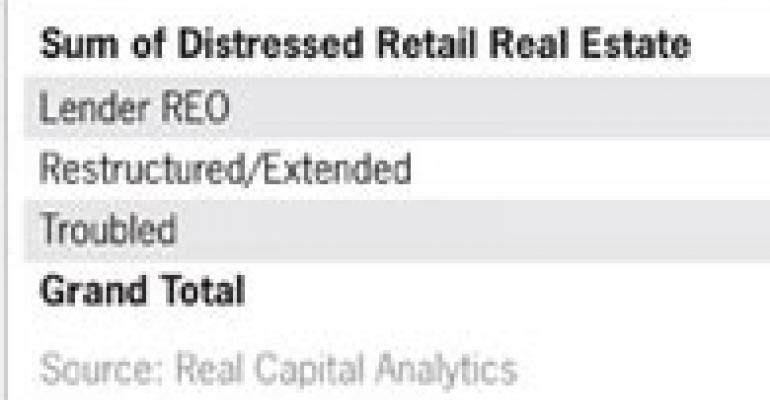As the retail real estate industry tries to work through a growing volume of troubled properties, one pressing issue owners and managers face is the attraction of new tenants. In the case of both owner-operated centers that are experiencing high vacancy rates as well as centers that have entered receivership or foreclosure, fixing occupancy gaps remains a crucial step on the road to recovery.
Retailers have been increasingly active in leasing new stores in recent months. But they are selective—opting for the best properties in strong markets. It is challenging for owners of struggling properties to convince merchants when a more attractive leasing opportunity may lie down the road.
By the numbers
Year-to-date in 2010, the volume of retail properties in distress in the U.S. reached $44.8 billion, according to Real Capital Analytics (RCA). Of that amount, $23.5 billion in properties have been identified as troubled, $3.5 billion are real estate owned (REO) and $17.8 billion have been granted loan extensions or restructurings.
Whatever the situation may be, owners and managers need to make sure occupancies are as high as possible to keep a consistent cash stream in place and put properties in situations to draw bids if they are put up for sale.
The good news is that tenants aren’t automatically writing off distressed centers as potential locations, says Branson Edwards, Chicago-based executive vice president and managing director of retail occupier services with brokerage firm Grubb & Ellis. Centers that are well located in strong markets with relatively high occupancies can draw interest regardless of their financial situation, he says.
Driving a hard bargain
Centers with high vacancy rates remain a tougher sell. In those instances, retailers want to make sure that current co-tenancies and foot traffic will be sufficient to make their stores successful. In fact, the first question prospective tenants often ask regarding a distressed center concerns an anchor store’s commitment to the property, says John Bemis, executive vice president and director of leasing with Jones Lang LaSalle Retail based in Atlanta.
In addition, tenants that rely heavily on foot traffic generated by neighboring stores, such as furniture, electronics and sporting goods retailers, might be too concerned about distress to enter into a new lease. But retailers that are more self-sufficient often see the spots in distressed centers as an opportunity to land a good deal. That’s why value-oriented chains are often open to leasing space at distressed centers, though they ask for very favorable leasing terms, notes Bemis.
“Retailers are going to be opportunistic, but they are really going to be cautious because their first concern is for the likelihood that the store is going to do the kind of revenue they need it to do,” says Edwards.

Tenants also want to know what’s being done to fix vacancies and improve the physical condition of a property, if it’s in disrepair. And for centers in receivership or foreclosure, tenants need reassurances that their leases will go through as planned and will not be delayed because of a lender’s refusal to approve transactions.
When a receiver or a bankruptcy trustee has taken over the management of the property from the original owner, new leases normally require approval from the lender, raising concerns among tenants that they won’t be able to open the store in time to meet their scheduled profit targets.
Plus, a receiver or a trustee may not always have the power to grant the same perks, including free rent and build-out allowances, that a tenant could get when working with the property owner directly, says Edwards.
Reassuring prospective tenants
Leslie Mader, vice president of retail services with CB Richard Ellis (CBRE), is currently working on the leasing campaign for the 285,000-square-foot retail portion of the Block 37 mixed-use project in Chicago. (CBRE has also been appointed as receiver for the property).
As she negotiates new leases, Mader has found that most prospective tenants are concerned about whether previously announced retailers will remain committed to the property. In addition, the tenants want to know whether CBRE will be able to provide them with build-out money.
“People weren’t sure if the leases that had been rumored to have been done were done,” Mader says. “And they want to know if we have money for tenant improvements. Yes, we do. That’s something that I had to assure people — that we are giving broker commissions and tenant allowances.”
Communicating with prospective tenants about what’s happening with the property is key to getting them to sign up. But Mader cautions leasing brokers against viewing distressed centers or centers in receivership or foreclosure as a liability. Today, many retailers might view those locations as an opportunity to enter into long-term deals at great prices, she says.
“If you look at it as ‘distressed,’ you are going to miss the opportunities that are there [because] the market has adjusted.”

